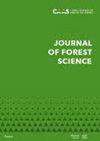农田造林对地表附近气温的影响
IF 1.1
Q3 FORESTRY
引用次数: 0
摘要
许多研究表明,植树造林增加了土壤的碳储量,并对土壤的物理、化学和生物特性产生了影响。植树造林可以影响当地和区域气候,这些影响在热带、温带和寒带地区有所不同。森林在保护土壤免受侵蚀方面也很有效,不同的出版物描述了它们的减轻洪水的功能或其他益处。本研究研究了在捷克温暖、温和干燥地区混合种植阔叶树种(栎、红栎和枫槭)或单一树种西尔松林分造林10年后,地表以上20 cm、40 cm和60 cm的气温变化规律。我们研究的目的是找出捷克共和国温和温暖、温和潮湿地区的山毛榉(Fagus sylvatica L.)森林中两个样地(一个样地-老山毛榉树,另一个样地-空地)的气温模式(地表以上20厘米、40厘米和60厘米)。农业用地的造林导致气温下降,并降低了最高和最低温度的幅度。与农业用地相比,造林地块2021年4月至11月初的平均气温下降了0.7 ~ 1.1℃。从2021年9月中旬到2021年11月中旬,在山毛榉林中,与老山毛榉相比,空地上的平均温度下降。我们的研究结果证实了植树造林对减缓气候变化的益处;极端温度的缓冲对人体热舒适至关重要。本文章由计算机程序翻译,如有差异,请以英文原文为准。
The impact of agricultural land afforestation on air temperatures near the surface
: Many studies showed that afforestation increases carbon storage and it can have effects on physical, chemical and biological properties of soil. Afforestation can affect local and regional climate and these effects differ between tropical, temperate and boreal areas. Forests are also efficient in protecting soils against erosion and their flood mitigation functions or other benefits are described in different publications. In this study, the pattern of air temperatures (20 cm, 40 cm and 60 cm above the surface) was studied 10 years after the afforestation of agricultural land (warm, mild dry region of the Czech Republic) with a mixture of broadleaved tree species ( Quercus robur L., Quercus rubra L. and Acer platanoides L.) or monospecific Pinus sylvestris L. stand. The aim of our study was to find out the pattern of air temperatures (20 cm, 40 cm and 60 cm above the surface) on two plots (one of the plots ‒ old beech trees, the other plot ‒ clearing) in a beech ( Fagus sylvatica L.) forest in a mildly warm, mildly wet region of the Czech Republic. The afforestation of agriculturally used land led to air temperature cooling and to a reduction of the amplitude of maximum and minimum temperatures. The average air temperature (from April 2021 to the beginning of November 2021) decreased by 0.7–1.1 °C on the afforested plots compared with the agriculturally used plot. In the beech forest, the average temperature decreased on the plot with clearing compared with the old beech trees (from the middle of September 2021 to the middle of November 2021). Our results confirm the benefits of afforestation to climate change mitigation; buffering of extreme temperatures is important for the human thermal comfort.
求助全文
通过发布文献求助,成功后即可免费获取论文全文。
去求助
来源期刊

Journal of forest science
Forestry-
CiteScore
2.30
自引率
9.10%
发文量
48
审稿时长
6 weeks
期刊介绍:
Original results of basic and applied research from all fields of forestry related to European forest ecosystems and their functions including those in the landscape and wood production chain are published in original scientific papers, short communications and review articles. Papers are published in English
 求助内容:
求助内容: 应助结果提醒方式:
应助结果提醒方式:


